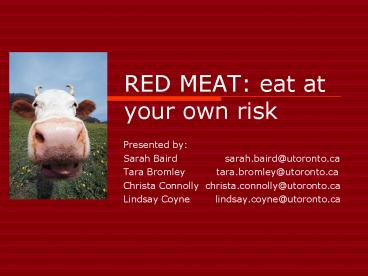RED MEAT: eat at your own risk - PowerPoint PPT Presentation
1 / 12
Title:
RED MEAT: eat at your own risk
Description:
... at your own risk. Presented by: Sarah Baird sarah.baird_at_utoronto.ca ... SA, Hughes, R., Cross ... 3. Hughes, R., Magee, E., and Bingham, S. (2000) Protein ... – PowerPoint PPT presentation
Number of Views:400
Avg rating:3.0/5.0
Title: RED MEAT: eat at your own risk
1
RED MEAT eat at your own risk
- Presented by
- Sarah Baird sarah.baird_at_utoronto.ca
- Tara Bromley tara.bromley_at_utoronto.ca
- Christa Connolly christa.connolly_at_utoronto.ca
- Lindsay Coyne lindsay.coyne_at_utoronto.ca
2
Outline
- What is red meat?
- How are endogenous toxins formed from red meat?
- The effect of these toxins on the body and their
link to colorectal cancer - Pharmacy connection
3
What is Red Meat?
- Beef, lamb, venison, and mutton1
- The components of red meat are protein, heme and
iron2 - Red meat has a higher heme content than white
meat3
4
How do the components of red meat become toxic?
- Heme is easily nitrosylated into a nitrosating
agent4 - These compounds are capable of donating NO
groups - Bacterial enzymes in the intestine break down
amino acids to form amines and amides2 - The catabolized amino acids are good substrates
for nitrosation and go on to form N-nitroso
compounds2 - N-nitroso compounds can be further reduced into
powerful alkylaters
5
DNA Methylation
- As powerful alkylaters, they can methylate DNA
bases5 - Methylation of DNA bases prevents proper
base-pairing5 - As a protective mechanism against this
alkylation, our body produces an enzyme called
O6-methyl-guanine DNA methyltransferase (MGMT)6
6
When MGMT goes wrong
- MGMT removes these methyl groups6
- If the methyl group is not removed, a DNA
mutation may occur6 - Specifically, if a guanine base is methylated and
left unrepaired, it will pair with thymine
instead of cytosine6 - So, during DNA replication, the wild-type G-C
pair is converted to an A-T pair6
7
Lewin, M., Bailey, N., Bandaletova, T., Bowman,
R., Cross, A., Pollock, J., Shuker, D. and
Bingham, S. (2006) Red Meat Enhances the Colonic
Formation of the DNA Adduct O6-Carboxymethyl
Guanine Implications for Colorectal Cancer Risk.
Cancer Research 663 pg. 1859-1864.
8
How Does Cancer Occur?
- Cancer occurs when methylation affects tumor
suppressing genes, silencing their activity and
preventing housekeeping mechanisms that keep cell
division in check7 - Hypermethylation of the promoter region of the
MGMT gene has been shown to silence it's
expression6 - This is found in approximately 40 of colorectal
carcinomas6 - Without MGMT, other bases can be methylated and
there is no longer a mechanism to reverse it
9
Colorectal Cancer
- 80 of cases are related to dietary factors3
- Red meat has been linked to colorectal cancer
because it is the area where bacteria that
catabolized amino acids into amines and amides
are present8 - Amines and amides are good substrates for
nitrosation8 - Once nitrosated, the N-nitroso compounds exhibit
carcinogenic activity8
Top picture www.mayoclinic.com Bottom two
pictures http//www2.jsasd.k12.pa.us/mhopple/Phys
iology/cancerwebs/Colon20Cancer.htm
10
Pharmacy Connection
- Colorectal cancer is the second most common cause
of cancer related deaths3 - Because there appears to be a dietary component,
prevention may be possible through lifestyle
changes - A balanced diet should be the main focus when
counseling a patient with concerns about red meat - Red meat is a good source of nutrients necessary
for proper growth and nutrition (e.g. B12, iron,
protein)9
11
Summary
- Red Meat contains heme and iron1
- Bacteria in the gut have enzymes that breakdown
the heme into nitrosating compounds4 - These compounds react with the dietary protein
from the red meat to make N-nitrosamine compounds
which are capable of methylating DNA bases2 - Methylation of the bases can cause inactivation
of tumor supressor genes, such as those for
MGMT7,6 - Without MGMT, further DNA base methylation cannot
be reversed, ultimately resulting in DNA
mutations and potentially uncontrolled cell
division6 - This uncontrolled cell division in the large
intestine has been linked to colorectal cancer8
12
References
- 1. MayoClinic.com. (2008) MayoClinic.com Tools
for Healthier Lives, retrieved Feb 10, 2008. - 2. Bingham, SA, Hughes, R., Cross AJ. (2002)
Effect of white versus red meat on endogenous
N-nitrosation in the human colon and further
evidence of a dose response. Journal of Nutrition
13211 3522-3535 - 3. Hughes, R., Magee, E., and Bingham, S. (2000)
Protein Degradation in the Large Intestine
Relevance to Colorectal Cancer. Current Issues in
Intestinal Microbiology. 1(2) 51-58. - 4. Kunhle, GCC., and Bingham, SA. (2007) Dietary
Meat, Endogenous Nitrosation and Colorectal
Cancer. Biochemical Society Transactions. 35 pt.
5 1355-1357 - 5. Lewin, M., Bailey, N., Bandaletova, T.,
Bowman, R., Cross, A., Pollock, J., Shuker, D.
and Bingham, S. (2006) Red Meat Enhances the
Colonic Formation of the DNA Adduct
O6-Carboxymethyl Guanine Implications for
Colorectal Cancer Risk. Cancer Research 663 pg.
1859-1864. - 6. Esteller, M, Toyota, M, Sanchez-Cespedes, M,
Capella, G, Peinado, M.A., Watkins, D.N., Issa,
J.P., Sidransky, D., Baylin, S.B., Herman, J.G.
(2000). Inactivation of the DNA repair gene
06-methylguanine-DNA methyltransferase by
promoter hypermethylation Is associated with G to
A mutations in K-ras in colorectal tumorigenesis.
Cancer Research 60 2368-71. - 7.Linhart, H., Lin, H., Yamada, Y., Moran, E.,
Steine, E., Gokhale, S., Lo, G., Cantu, E.,
Ehrich, M., He, T., Meissner, A., and Jaenisc, R.
(2007) Dnmt3b promotes tumorigensis in vivo by
gene-specific de novo methylation and
transcriptional silencing. Genes and Development.
Accessed Jeb 10, 2008 from http//www.wi.mit.edu/
news/archives/2007/rj_1201.html - 8. Cross, A. and Sinha, R. (2004). Meat-Related
Mutagens/Carcinoge - ns In the Etiology of Colorectal Cancer.
Environmental and Molecular Mutagenesis. 4444-55 - 9. Henderson, Jeff (2008). Iron Homeostasis,
Toxicity and the Treatment of Anemia and
Hypomethylation, Folic Acid Metabolism and
Vitamin B12. Given to PHM 226H at the Leslie Dan
Faculty of Pharmacy, University of Toronto on Jan
29, 2008 and Jan 30, 2008 respectively.































